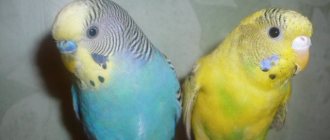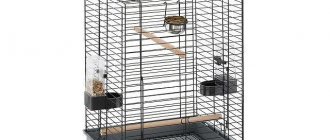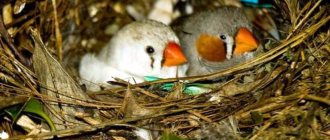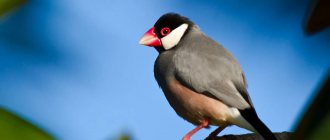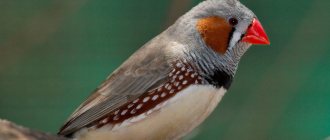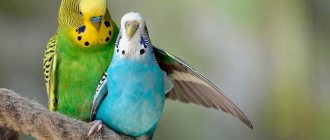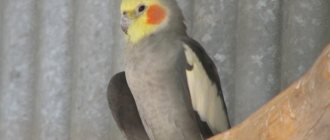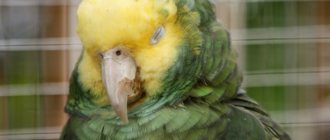If you love pets, consider breeding parrots as a business idea. These funny birds often become members of the family - especially in cities where everyone lives in multi-storey buildings and there is not always enough space for a cat or dog. Unlike larger pets, a parrot does not require much space and does not need to be walked.
The main advantage for a businessman is that one pair of birds is capable of giving birth several times a year, that is, producing 16-20 chicks annually. Let’s look at how to create a business with these birds, what is needed to breed parrots, and how much you can earn from it.
Features of the parrot breeding business
A business in breeding exotic birds is worth starting if you love them and are interested in them. Such a project has its own characteristics that are worth studying before you buy parrots and start preparing housing for them.
- It will take time to care for and care for the birds. Pets need to be regularly monitored, fed, checked for physical and psychological condition, and cared for for them and their offspring. When you have 2-3 pairs of parrots, this will not take much time, but if we are talking about 50 pairs, you need much more resources. Despite this, such a business can be combined with your main job. Another option is to involve your relatives in caring for the animals.
- To start a business, you do not need to purchase expensive equipment, rent a separate room and invest large sums. To purchase several pairs of birds and everything necessary for them, you will not need more than 20-30 thousand rubles.
- At first - at least three months - the business will not generate income until the birds get used to the new environment, form pairs and begin to lay eggs. Therefore, you will have to be patient and be prepared to wait for a return.
- Each type of bird has its own characteristics and difficulties in caring for. For example, some can only breed in an enclosure, others need a lot of space, and others need special conditions and food.
- Before starting a business, you need to analyze the market, possible sales options and how profitable this idea is for you specifically.
- Parrots do not require a separate room. You can breed in an apartment if you can allocate a separate room for them. After all, pets are noisy, require special temperature conditions, light, and the smell in the enclosure will be specific. Therefore, living in the same room with several dozen birds is not a good idea.
- You can register an individual entrepreneur, especially if you plan to work with pet stores, or register as a self-employed citizen - if you do not hire employees and your annual income does not exceed 2.4 million rubles. When registering an individual entrepreneur, indicate OKVED code 01.49 – Breeding of other animals.
Construction
Preliminary preparation
Before you start building a house, you need to put drawings on paper for the future structure. With their help, you can evenly cut or saw out the necessary parts. There is no need to make the nesting house too large, because it will have to be attached to the outside of the cage and the heavy house will topple the cage. Approximate dimensions of the future structure:
- height - twenty centimeters;
- length - twenty-five centimeters;
- width - fifteen centimeters.
Now prepare the material for construction. The nesting house is best made from well-dried and tightly fitted boards made of linden, birch, cherry, apple or rowan. If it is not possible to purchase natural material, then you can use high-quality thick plywood. However, in this case the bottom should still be wooden.
For more precise work, you can install additional lighting. You will also need the following items:
- saw;
- screws;
- screwdriver;
- drill;
- drill bit;
- hammer;
- nails;
- hinges for the lid;
- hooks
Let's start the process
Using the drawings, cut out six parts: the bottom, four walls, and the lid. Moreover, the thickness of the bottom should be three centimeters. Other details - no less than one and a half centimeters, but no more than two and a half centimeters.
In one of the two large walls of the structure it is necessary to make a hole with a diameter of about five centimeters. This will be the entrance. It should be three centimeters below the lid. It is not necessary to cut the entrance directly in the center; it is best to move it to the side, but no closer than three centimeters from the beginning of the wall.
Under the entrance, no lower than three centimeters, it is necessary to fix the perch so that it protrudes ten centimeters from the outside and three centimeters from the inside. With its help, it will be convenient for the female to enter and exit the nesting house. It will also be convenient for the male when he begins to feed his beloved.
In the plank from which you will make the floor in the house, using a drill and a suitable crown you need to make a recess of two centimeters and a diameter of eight to ten centimeters. Here the female will hatch the eggs. The recess should be located on the side of the entrance.
And right under the entrance to the bottom you need to install a step seven centimeters wide and length from wall to wall. It must be secured with a hammer and small nails. It is on the step that the female will jump from the perch. This arrangement of amenities along the bottom of the structure will save the clutch from sudden damage from the female.
Don't forget to drill two or three rows of small holes along the bottom of the house. This is necessary so that air can flow inside. During the hot season, you can place a bowl of water under the house. Water vapor will penetrate from it through the holes, thereby humidifying the air and preventing the chicks from overheating.
After you have finally prepared the parts for the future house, everything except the lid must be carefully fastened together using screws and a screwdriver. This must be done in such a way that the screws do not extend beyond the edges of the parts, especially into the structure.
It is best to attach the lid to the wall using hinges so that it can be opened at any time for interior cleaning of the house. For convenience, you can attach a handle to the lid. On the sides of the top of the wall of the structure where the entrance is located, you need to screw two hooks. They will help secure the nesting house to the outside of the cage.
What types of parrots to breed
Before you start breeding parrots, it is worth carefully studying the market and all types of these exotic birds. Larger and rarer bird species will bring much more profit, but will also require more investment, as well as experience and knowledge. Therefore, you should start with small species of parrots, which are popular and do not require complex care.
- Lovebirds . This is a popular species of parrots that attracts attention with its beautiful bright colors and activity. It is believed that pairs of these birds choose each other once and for all. They are also bought in pairs. The price of the birds is 1000-1500 thousand rubles, and they are capable of producing an average of 6 chicks at a time.
- Budgerigars. This bright and cheerful bird is considered the most popular species of parrot. After all, they are easy to care for, can talk, bear offspring 3-4 times a year, and are inexpensive - only 500-2500 rubles.
- Necklace parrots are larger and brighter representatives than the previous ones. The price starts from 8,500 rubles, and at a time they bring up to 4 chicks.
- Another bright and popular species of parrot is Corella. They have a medium size, beautiful colors and a funny tuft on top. The price for a bird starts from 1,700 rubles.
- Larger species (Ara, Cockatoo, Gray) are best bred after you have learned how to deal with small birds.
It is better not to stop at one type of bird and breed at least 2-3 species, one of which is a talking one.
Possible risks
It's not easy to breed parrots. A potential couple should not only be of the same species, but also have a good relationship and be psychologically compatible. This will allow them to create a strong union. After all, birds spend most of their time together, cleaning each other’s feathers. It is almost impossible to force individuals to be together. Even if this succeeds, they may not produce offspring.
The female may refuse to raise the chicks. Then you will have to entrust this task to another individual. Otherwise, the chicks may die.
To avoid risks, an entrepreneur should gradually increase the number of birds. This way he will be able to gradually reduce their cost, because he will need less money to feed them, pay for heating and light.
Conditions and difficulties of breeding ornamental birds
Simply buying a male and female parrot and expecting offspring will not work. Parrots, like people, can express sympathy and fall in love. They need the opportunity to choose their own mate. There is a possibility that the female and male will dislike each other and will not lay eggs. It is better to buy several pairs of birds, place them together and keep track of who shows sympathy for whom. Then the loving couple needs to be separated from the rest.
In order for birds to feel good and develop normally, they must have appropriate conditions. The room temperature should be at least +18C, but it should not be too high, otherwise it will have a bad effect on the chicks. And the air humidity should be at least 70%. To do this, you should buy an air humidifier or place containers with water near the radiator.
The process of hatching and feeding chicks is also worth paying attention to. There are times when the female stops hatching the eggs, pecks them, or pecks and throws the small chicks out of the nest. There may be various reasons for this, but you need to monitor it and react in time.
If the female left eggs, you need to place them on another female so that the offspring do not die. And chicks that have fallen out of favor will most likely need separate space and artificial feeding.
If you want to get healthy and strong offspring, follow the rules of their breeding. You cannot mate a male and a female with the same offspring. The chicks from such a union will be weak and are unlikely to live long. Also, you should not take too young females for this. Although parrots are considered capable of breeding already at six months of age, you should not mix them with males before a year. The same applies to mature birds. The suitable age for mating parrots is 1-5 years.
For proper development of birds, the duration of daylight should be at least 11-12 hours. When the female incubates the chicks, the period can increase to 15 hours. If it gets dark early in your region, be sure to use artificial lighting.
Not all birds can breed in cages. For some species, an aviary is required, the size of which depends on the size of the bird and the number of pets. But they should have enough free space to move around their home.
Arrangement of cages and nests for offspring
Once you have decided on the species, you need to prepare the cages before purchasing pairs for breeding. The minimum dimensions of the space for keeping parrots should be 0.6 meters in length and 0.4 meters in height. Otherwise, the birds will not reproduce well.
For example, to actively raise their offspring, budgerigars must live in a flock, which means it is better to choose a common large cage for all pairs.
A common cage will also be required so that lovebirds can choose a mate. It will not work to do this artificially, simply by choosing it yourself.
The internal equipment of the cage should include:
- Wooden perches;
- Several feeders for different types of food;
- Several drinkers, one for three to four birds;
- Toys and swings for games and exercise;
- Twigs for sharpening beaks.
The arrangement of nests deserves special attention. They come in three types of designs:
- Horizontal - a box elongated in width, the height of which allows the parrot to move only horizontally. The disadvantage is the possibility of accidental loss of chicks.
- Vertical - a box elongated in height, allowing the female to move vertically. The main disadvantage is the likelihood of accidental damage to the eggs and brood by the female.
- Combined - a large box that allows birds to move in all directions. The disadvantage of such a nest is that it takes up a lot of space in individual cages.
The nest box is hung outside the cage, having made an entrance hole in advance, or to its ceiling at a distance of about 20 centimeters. The bottom of the nest box should have a recess, which allows the eggs to be constantly in one place. Sawdust is used as insulating bedding, but only for those bird species that need it. The number of nests must correspond to the number of reproductive couples.
This is what a nest for lovebirds in an aviary might look like
Selecting a room
An aviary for birds in an apartment or house is the best option for breeding birds. Its size depends on the number of parrots and the free space you can allocate to it. It is ideal if you can insulate the balcony and place the enclosure there. This will give the birds more access to daylight. You also need to take care to constantly maintain the temperature and humidity at the required level.
In the aviary you need to place nests where birds can nest and hatch eggs.
To prevent birds from quarreling among themselves, place them higher, but at the same height and at a sufficient distance from each other. For nests, it is best to purchase wooden bird houses from specialized stores.
Also place toys, ladders and other items that will help the birds not get bored and exercise. After all, they will not have the opportunity to fly freely, and the lack of physical activity can negatively affect their health.
The appearance of chicks
The first chick appears in the nest 18-19 days after the start of incubation. You should not watch budgerigar chicks hatching, otherwise the female will become alarmed. The sacrament of birth occurs like this: cracks become visible on the shell, which gradually expand, and then the shell breaks in two. To crack the shell, the chick uses a bone growth on its beak - the so-called “egg tooth”. If the baby is weak, the female will help him break his way out of captivity.
Newborn chick
The birds appear one after another, most often in the same order as the eggs were laid. The number of eggs determines how many days the chicks will hatch. If 4 weeks have passed since the start of nesting, the remaining eggs can be removed - they will no longer hatch into chicks.
Equipment purchase
To breed birds you do not need to purchase a lot of different equipment. You will need:
- Aviary (or galvanized mesh, if you do it yourself)
- Drinkers and feeders
- Wooden houses or other types of nests
- Cells
Equipment costs will be about 20-30 thousand rubles. It is also worth purchasing a sufficient amount of food. Give preference to Italian and Belgian manufacturers.
Step by step plan
If an entrepreneur has never been involved in breeding parrots before, then he needs to act in the following sequence:
- comparing prices in pet stores, searching for possible sales options;
- studying the characteristics of cultivation;
- search for premises;
- purchase or production of cages, enclosures and other necessary equipment;
- purchase of individuals.
At the initial stage, it is not necessary to purchase a lot of parrots. It is enough to get a female and a male. They will help you study their habits, understand how to care for them, and what to feed them. At this stage, you should decide on the variety of parrots. Even in one year, an adult is capable of giving birth to 15–20 chicks. But it will not be possible to cross them with each other. Then you will need to buy more parrots.
Parrot care
Breeding budgies at home is easier than breeding other birds. The same applies to other small species (Corella, lovebirds).
Be sure to follow all recommendations for creating normal indoor conditions for birds.
- Temperature, air humidity, pets' housing must meet the requirements.
- A small breed bird eats approximately 20 g of feed per day. Parrots should be fed 2-4 times a day, depending on age and breed. Pay attention to the composition of the feed. They must be balanced and have all the necessary vitamins and microelements. Also include fresh herbs, chopped boiled eggs, fruits and vegetables in your diet. Periodically give your parrots crushed eggshells and chalk.
- Watch the behavior of the birds. If you see something strange and atypical in the actions of your pets, be sure to consult a doctor.
- Every few months, disinfect your bird's waterers, feeders, and other items in your bird's cage. If you let birds chew on branches, be sure to scald them before doing so.
- Trim the claws in a timely manner so that they do not interfere with the birds. The beak can also grow back in captivity. Therefore, also carefully trim it and file it with very fine sandpaper, if necessary.
- Let birds fly regularly, otherwise their muscles may atrophy.
Preparation for masonry
Most often, owners of budgerigars begin to prepare the birds for nesting about two weeks before installing the nest house in the cage.
Make sure that the cage is in a quiet and peaceful place and do not disturb the birds unnecessarily during this period of time.
The room temperature should be no lower than 15 C, daylight hours should be 14-16 hours (if necessary, add artificial lighting with a smooth transition so as not to provoke molting in birds). Heat is also dangerous for embryos, so the upper limit of air temperature should also be controlled.
How much money do you need to start a business?
To start a business you need about 20-30 thousand rubles, not counting the cost of purchasing the parrots themselves. To begin with, it is enough to buy 4-6 pairs of parrots. This will cost about 3-5 thousand rubles. Keep in mind that during the first 3-4 months you are unlikely to see offspring, and, accordingly, profit. You will also have monthly expenses for food, electricity (extending daylight hours in winter - at least another 2,000 rubles per month.
Financial results
To open his own business, an entrepreneur will need equipment (10,000 rubles): young animals (5,000 rubles), feed for the first time (for 3 months - 4,000 rubles). It turns out that even 20,000 rubles will be enough to open a business. When purchasing larger individuals, a larger investment may be required.
If an entrepreneur decides to start with 5 pairs, then in a month he can get about 6,000 rubles in profit. But the first money will appear after 3 months, no less. It turns out that the return on investment will be about 6–7 months. The profitability level in this industry is about 50%, but over time, by increasing the number of individuals, it will be possible to achieve more impressive results.
How much can you earn from breeding parrots?
It is quite difficult to name the exact amount of income from a business, because it directly depends on the number of individuals sold and the type of parrots that you breed. Budgerigars can be sold to pet stores for a price of 500 rubles, and if sold independently, the price can double. Chicks can be sold when they are 15.2-2 months old. Food for one chick will cost about 150-250 rubles.
The more pets you have, the less it will cost to maintain each of them.
On average, the payback of a business for 4-5 pairs of birds occurs in 6-8 months. With a large number of birds this will happen faster.
Creating a Nest
The nest for breeding budgerigars or Congo parrots is not a common design like that of outdoor birds. It is more like a birdhouse, the main difference is that it is suspended from the bars of the cage. A suitable house can be purchased at a pet store; three options are available: vertical, horizontal and combined.
You can make a nest suitable for breeding yourself. In this case, you need to carefully consider the choice of materials. Boards made of linden, rowan or birch are best suited.
Sales market: where to sell parrots
In order to sell the offspring, you will need to obtain a conclusion from a veterinarian that the birds are healthy, they do not have salmonellosis, psittacosis and other diseases. After this, you can negotiate the sale of birds. The following sales channels should be used:
- Pet stores. Make arrangements with local pet stores to supply them with parrots. The payment will not be as high as when selling without intermediaries, but you will get a stable distribution channel, where replenishment is always required.
- Social media. Create profiles on social networks and sell birds through them. Now this is a very popular and effective method.
- Notice boards, thematic forums and city public pages. Periodically post advertisements for the sale of birds on these resources. They are also in demand among buyers.
First flight of chicks
Starting from the 24th day of life until the chick’s first flight from the nest, its weight decreases somewhat, which is explained by its energetic movements. As soon as the last chick flies out of the nest, the nest is carefully checked, as new clutches are often found there - eggs stained with droppings. They are transferred to a clean nest.
For an amateur, the flight of chicks is the moment of supreme pleasure. A chick sits on a branch, a little smaller than an adult parrot, with large dark eyes and amazingly examines the world around it. For the most part, the chicks fly nimbly and return to the nest already on the first day. Fully fledged, healthy chicks fly out of the nest at approximately 35 days of age. They are slightly smaller in size than their parents, the wavy on the head extends across the forehead to the base of the beak, and their coloring is less bright compared to their parents, their eyes are black, and there is a noticeable black spot at the tip of the beak. The cere and mandible of the chicks are pink, later - white with a bluish tint.
Chicks can be left with their parents in a cage for approximately 14 days after the last chick has fledged; They do not disturb subsequent nesting, since they no longer return to the nest. Then they need to be transplanted into a flying cage, where they fly freely, gradually turning into strong and healthy birds.
For a novice hobbyist who has hatched chicks for the first time, of course, there is a great temptation to look into the nest and see with his own eyes how the babies grow and develop. Usually the female reacts calmly to the owner’s intervention. Many birds remain calmly sitting on the clutch or brood, without particularly worrying. But it’s better not to do this, as there may be unpleasant consequences later in the form of pecked eggs or abandoned chicks. Therefore, in order to get a good look at everything, choose a moment when the bird is not there. Some birds become so accustomed to daily control by their owner that they even move aside or leave the nest.
Incubation period
After the first egg appears, the incubation period begins. It lasts approximately 18 days. Dense incubation of the clutch by the female begins after the appearance of all the eggs, which can be counted from 1 to 4 pieces.
During nesting, the female needs increased nutrition. Her diet should include:
- 1/8 chicken or ½ quail egg (1–2 days before the appearance of the first chick);
- greens, fruits and red vegetables (sweet peppers, carrots, pumpkin, dandelions, quinoa, chickweed, clover);
- a mixture of brewer's yeast with phosphorus and calcium gluconate (ratio 1: 1);
- sprouted grains (3–5 times a week in the amount of half the grain ration);
- vitamin preparation Radostin® Vitasil for the prevention and treatment of hypovitaminosis.
The rate of grain feed during the nesting period should be increased by 2–3 times. In this case, the amount of sprouted grain must be gradually reduced and completely removed until the chick is 15 days old.
The courtship process: what precedes mating
The behavior of parrots during the mating season is very interesting. The male becomes especially attentive to his girlfriend: he cleans her feathers, tries to feed her from his beak, chirps and sings provocatively, dances, showing off in front of her in all possible ways (shakes his head, raises his crest, spreads his wings, fluffs his tail).
If the female accepts his advances, she also caresses him, squints her eyes, and sits pressed close to her suitor. The female, ready for mating, tilts her head favorably, sits lower on the perch, the male first throws one paw on her, then the other, then climbs on her and, moving her tail and hugging her with his wings, begins characteristic movements.
In this video, watch how Corella parrots have intercourse:
From egg to chick
The female lays from 3 to 10 eggs. If fertilization is successful, the first egg appears in the clutch after 18 days, which is how long the incubation period lasts.
Sometimes fertilization fails, and the first egg appears six months later. Each new egg is hatched every other day. The number of eggs varies, from three to ten pieces, usually 5-6. In young individuals, the number of eggs is minimal, in females with experience - more. As soon as 2-3 eggs appear, the female prepares to hatch. The partner continues to care for the female, feeds her, but does not participate in incubation.
Newborn chicks bear little resemblance to their parents. The offspring, blind and bare-skinned, lie on their backs for the first three days. After a week, the eyes open, and after ten days the first signs of plumage appear.
At two weeks the parrot is covered with down and its flight and tail feathers are formed. By three weeks the pet is considered mature. After about a month, the chicks leave the nesting house, and after a couple of days they are moved to a separate home.
